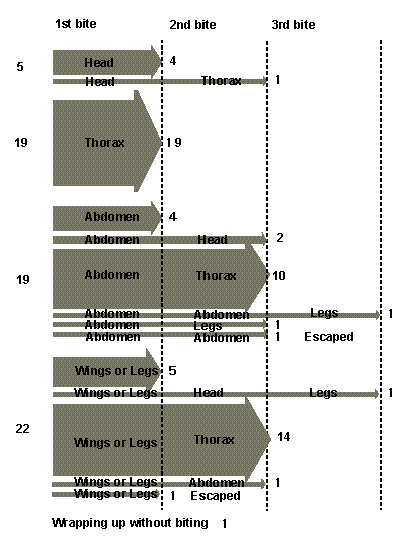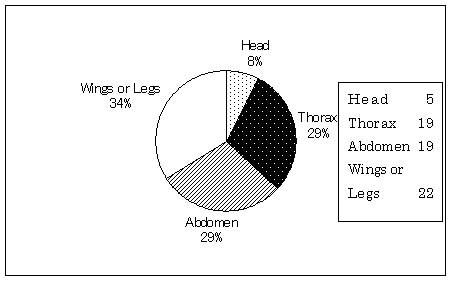The biting behavior of the orb web spider Nephila clavata
Aug. 2,2005. M.Sekine
The orb web spider, Nephila clavata, bites its prey before it
wraps up its prey in silk, because it has as little silk for wrapping up
its prey as the genera Tetragnatha and Cyrtarachne. (Shinkai, E. and Takano,
S., 1987. Kumo Kihon 50. [translation: The Fifty Basic Spiders.] Shinrin-Shobo,Tokyo.
) Some nature books for children explain that this spider takes aim and
bites the head or the thorax of its prey entirely in the first instance.
(Oda, H. and Nanba, Y., 1999. Ami o Haru Kumo Kansatsu Jiten.[translation:
Observations on the Weaving of Spider Webs.] Kaiseisha,Tokyo.) This explanation
sounds plausible. Can that be true?
 I threw the two-spotted cricket, Gryllus bimaculatus, (with a
length from 23 mm to 25 mm) into the spider's web. Then I observed how the
female Nephila clavata (a length from 20 mm to 30 mm), located in
the upper part of its web, made a dash for the cricket and bit the cricket
before it wrapped up its prey. I did this on 66 separate incidences on Oct.
31, Nov. 3, Nov. 14 and Nov. 21, 2004 in Nara Prefecture. I threw the two-spotted cricket, Gryllus bimaculatus, (with a
length from 23 mm to 25 mm) into the spider's web. Then I observed how the
female Nephila clavata (a length from 20 mm to 30 mm), located in
the upper part of its web, made a dash for the cricket and bit the cricket
before it wrapped up its prey. I did this on 66 separate incidences on Oct.
31, Nov. 3, Nov. 14 and Nov. 21, 2004 in Nara Prefecture.
 When I threw each cricket into the spider's web, the cricket was attached
to the web at different angles. Then the cricket floundered in the web,
so the cricket often faced downwards. When I threw each cricket into the spider's web, the cricket was attached
to the web at different angles. Then the cricket floundered in the web,
so the cricket often faced downwards.
 Also, on 6 occasions the crickets were located with its head facing
upwards. In these cases, the first bite of the spider was mostly on the
head of its prey. In 83% of instances this occurred. Also, on 8 other occasions
the cricket's heads faced sideways. Finally in 52 instances, the cricket's
heads faced downwards. In these cases, the first bite of the spider on the
thorax, abdomen, wings or legs occurred at an almost equal rate. (See Figs.
2-3) It suggests that the spider bites the near part of the cricket, i.e.
the head, thorax, abdomen, wings or legs in the first instance. Also, on 6 occasions the crickets were located with its head facing
upwards. In these cases, the first bite of the spider was mostly on the
head of its prey. In 83% of instances this occurred. Also, on 8 other occasions
the cricket's heads faced sideways. Finally in 52 instances, the cricket's
heads faced downwards. In these cases, the first bite of the spider on the
thorax, abdomen, wings or legs occurred at an almost equal rate. (See Figs.
2-3) It suggests that the spider bites the near part of the cricket, i.e.
the head, thorax, abdomen, wings or legs in the first instance.
 When the spider bit the head or the thorax of its prey for the first
time, the spider wrapped up its prey immediately. Regarding the head, it
occurred 80% of the time. But with the thorax, it occurred 100% of the time.
(See Fig. 1) But, if the first bite of the spider was not on the head or
the thorax of the prey, the spider tried to bite it again. More often than
not it was to the thorax. (See Fig. 4) After the second bite at the thorax,
the spider wrapped up its prey immediately. (See Fig. 1) When the spider bit the head or the thorax of its prey for the first
time, the spider wrapped up its prey immediately. Regarding the head, it
occurred 80% of the time. But with the thorax, it occurred 100% of the time.
(See Fig. 1) But, if the first bite of the spider was not on the head or
the thorax of the prey, the spider tried to bite it again. More often than
not it was to the thorax. (See Fig. 4) After the second bite at the thorax,
the spider wrapped up its prey immediately. (See Fig. 1)
 On whichever parts of the prey the spider bit for the first time, if
the prey didn't get weakened and still struggled, the spider might try to
bite the nearby part of its prey again. I suppose that the second bite of
the spider is at the thorax as a natural result, because the thorax is the
middle part of insects' body. Perhaps, when the spider bites the head or
the thorax of its prey, the venom, which the spider injects into its prey,
has an effect on its prey. I suppose that the spider injects the venom into
the nearby part of the nervous systems of insects. On whichever parts of the prey the spider bit for the first time, if
the prey didn't get weakened and still struggled, the spider might try to
bite the nearby part of its prey again. I suppose that the second bite of
the spider is at the thorax as a natural result, because the thorax is the
middle part of insects' body. Perhaps, when the spider bites the head or
the thorax of its prey, the venom, which the spider injects into its prey,
has an effect on its prey. I suppose that the spider injects the venom into
the nearby part of the nervous systems of insects.
 Another interesting point is that, viewed as a percentage, the spider
wrapped up its prey immediately when the first bite was on the wings or
legs 23% of the time. Perhaps, the spider bit the base of wings, so it had
the same effect on its prey as on the thorax. Another interesting point is that, viewed as a percentage, the spider
wrapped up its prey immediately when the first bite was on the wings or
legs 23% of the time. Perhaps, the spider bit the base of wings, so it had
the same effect on its prey as on the thorax.
 In conclusion, when the cricket is caught in a spider's web, the female
Nephila clavata bites the near part of the cricket, i.e. the head,
thorax, abdomen, wings or legs in the first instance. If the first bite
of the spider is not on the head or the thorax of its prey, the spider tries
to bite it again. More often than not it is to the thorax. In conclusion, when the cricket is caught in a spider's web, the female
Nephila clavata bites the near part of the cricket, i.e. the head,
thorax, abdomen, wings or legs in the first instance. If the first bite
of the spider is not on the head or the thorax of its prey, the spider tries
to bite it again. More often than not it is to the thorax.
 In addition, one case was observed in which the spider bit at the tip
of the abdomen of its prey and the next bite was at the anterior part of
the abdomen, and the cricket escaped. Also, one case was observed in which
the spider bit the leg off its prey and the cricket escaped. In the other
case, the spider wrapped up its prey immediately without biting it. Perhaps,
in the latter case, the prey was small and weakened, so it was not necessary
for the spider to bite its prey. In addition, one case was observed in which the spider bit at the tip
of the abdomen of its prey and the next bite was at the anterior part of
the abdomen, and the cricket escaped. Also, one case was observed in which
the spider bit the leg off its prey and the cricket escaped. In the other
case, the spider wrapped up its prey immediately without biting it. Perhaps,
in the latter case, the prey was small and weakened, so it was not necessary
for the spider to bite its prey.

Fig. 1 The relationship between which parts of its prey the spider bit
and the subsequent action of the spider.

Fig. 2 A pie graph on which part of the prey the spider bit in the first
instance. (n=65)

Fig. 3 The correlation between the position of the prey and on which
part of the prey the spider bit in the first instance. (n=65)

Fig. 4 The comparison between the part of the prey re the first bite
and the second bite of the spider when the spider didn't wrap up its prey
after the first bite.
See also: Wikipedia Deutsch
RETURN |



